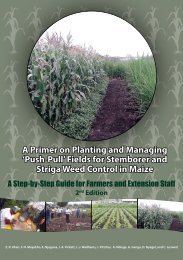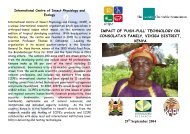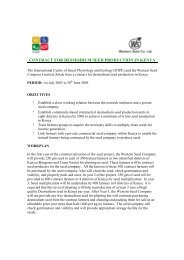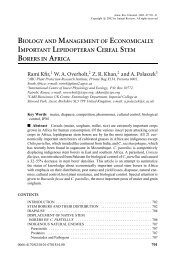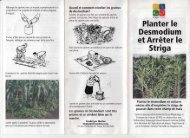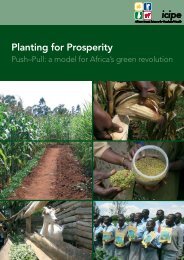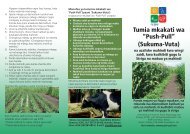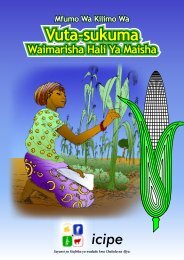The Royal Society Report - Push-Pull
The Royal Society Report - Push-Pull
The Royal Society Report - Push-Pull
Create successful ePaper yourself
Turn your PDF publications into a flip-book with our unique Google optimized e-Paper software.
Figure 1.6. World fertiliser consumption (1961–2005).<br />
Ratio (1961 = 1)<br />
10<br />
9<br />
8<br />
7<br />
6<br />
5<br />
4<br />
3<br />
2<br />
1<br />
World fertiliser consumption (1961–2005)<br />
(FAO, 2009)<br />
0<br />
1960 1970 1980 1990 2000 2010<br />
All fertilisers<br />
(1961 = 31.2 Mt)<br />
Nitrogenous fertilisers<br />
(1961 = 11.6 Mt)<br />
Figure 1.7. Irrigated area and agricultural machinery (1961–2006).<br />
3<br />
Irrigated area and agricultural machinery, world<br />
(1961–2006) (FAO, 2009)<br />
2.5<br />
Ratio (1961 = 1)<br />
2<br />
1.5<br />
1<br />
Irrigation area<br />
(1961=139 M ha)<br />
Tractors, harvesters and<br />
threshers (1961=13.6 M)<br />
0.5<br />
1960 1970 1980 1990 2000 2010<br />
and fertilisers, did not suit green revolution crop varieties<br />
(Paarlberg 2006). Other social side effects of the green<br />
revolution include mechanisation replacing manual labour<br />
and worsening poverty in some rural areas (Conway 1997).<br />
<strong>The</strong>se successes and limitations of the first green<br />
revolution have led to many calls for renewed investment<br />
and collaboration directed at step changes in agricultural<br />
productivity, albeit with greater consideration of possible<br />
side effects. <strong>The</strong>re have been calls for a ‘greener revolution’<br />
(<strong>The</strong> Independent 2008), a ‘doubly-green revolution’<br />
(Conway 1997) an ‘evergreen revolution’ (Swaminathan<br />
2000), a ‘blue revolution’ (Annan 2000) and an ‘African<br />
green revolution’ (Sanchez et al. 2009a) which would<br />
replicate the successes of original efforts in new places,<br />
while this time being more equitable, resilient and socially<br />
and environmentally sustainable.<br />
In 2007, the world’s farmers produced 2.3 billion tonnes<br />
of grain (80% of which was wheat, rice and maize)<br />
and another 0.5 billion tonnes of roots and tubers (see<br />
Figures 1.1 and 1.2). Cereal production was 4.7% up on<br />
2006 and 2.7 times the amount that was being produced<br />
50 years ago (0.83 billion tonnes). However, a large<br />
proportion of this plant material is removed for livestock<br />
feed, and a growing amount for biofuel production.<br />
Since a peak of around 250 kg per person worldwide in<br />
1995, per capita availability of cereal and roots has<br />
dropped back to near 1960s levels of around 220 kg/<br />
person of grain available for direct food use (FAOSTAT<br />
2009). Reduced availability of these staples affects the<br />
world’s poor most acutely.<br />
<strong>The</strong> necessary changes to global agriculture are not just a<br />
matter of quantity. In addition to increasing yield, there are<br />
further challenges concerning food quality, nutritional<br />
benefit, distribution to match production with need,<br />
managing potentially adverse impacts, and reducing the<br />
environmental impact of technological change. All of these<br />
depend to a greater or lesser degree on scientific research.<br />
<strong>The</strong> green revolution was built on decades of substantial<br />
global investment in agricultural research. <strong>The</strong> outcomes<br />
4 I October 2009 I Reaping the Benefits <strong>The</strong> <strong>Royal</strong> <strong>Society</strong>



